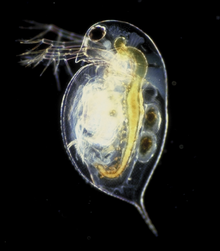Climate Change and Daphnia
November 2010

On Lake Champlain we have become accustomed to winters when the lake no longer freezes over completely. From the mid 1800s, the time of the first available records, until the 1950s it was almost a given that the lake would freeze over each year. Since then, on average the lake freezes every other year. However, on many lakes freeze over is still a regular occurrence, and a recent report from Germany suggests that when lakes that regularly freeze do not, the results can be dramatic.
The researchers had been studying Daphnia, a major component of the lake’s open water biota. Daphnia are a group of small crustaceans that feed upon smaller animals and plants in the water. In turn, they are an important food source for many fish species. They have limited mobility and depend principally on the currents in the water for transport. They are common in most every lake system including Lake Champlain.
Daphnia are named for a nymph in Greek mythology. She argued with Cupid and he struck her with an arrow of lead so that she would not desire the love of a man. Ovid says of her “The nuptial torch seemed criminal to her.” The god Apollo pressed his affections on her against her wishes. So insistent was she on avoiding Apollo’s attentions that she prayed to her father the river god, “Destroy the beauty that has injured me or change the body that destroys my life”. He answered her prayer and transformed her into a laurel tree. Even as a tree Apollo loved her, and the laurel became his symbol, given to victors in contests in his name.
Like the nymph, Daphnia of lakes rarely mate with males. Instead, females lay unfertilized eggs, a process known as parthenogenesis (Greek for ‘virgin birth’). However, in some species females do mate with males later in the season. They produce ‘resting eggs’ that sink to the bottom of the lake. Resting eggs can survive extreme conditions and hatch when conditions improve.
Between 2005 and 2007 the German researchers studied the genetic structure of a certain Daphnia species complex in Saidenbach Reservoir. The reservoir spent three months under ice in every year of its existence until the warm winter of 2006-7. The following summer, the researchers found a dramatic shift in the genetic composition of the surviving population.
The species complex in question has two groups – hyaline (translucent) and galeata (helmeted). Prior to the warm winter the translucent Daphnia were more common, but after the warm winter, hybrids dominated. Further work demonstrated that the translucent Daphnia came from resting eggs whereas helmeted Daphnia were more likely to survive winter as adults. Presumably, the mild winter favored the survival of more helmeted adults and increased their contribution to the gene pool during the subsequent summer.
Daphnia are not the only aquatic species responding to climate change. In Alaska, increased growth of mussels has been correlated with higher air temperatures over the last 50 years. Meanwhile, slower growth is correlated with longer spring ice cover. Temperature limits the ability of Eurasian water milfoil seeds to germinate, so warmer temperatures should facilitate germination.
In Lake Washington near Seattle, researchers have seen a decline in Daphnia that they associate with climate change. Daphnia populations used to peak at the same time as algae populations, thus assuring a large amount of food for growing Daphnia. However, in recent years, algae populations have peaked earlier than Daphnia, and as a result the Daphnia populations have been declining. The German researchers suggest that their work lends hope for Daphnia. The micro-evolutionary processes they described “may dampen possible seasonal mismatches between daphnid populations and their food or predator populations.”
The biological interactions that vary as a result of climate change in Lake Champlain and other waterbodies will be complex and difficult to predict. Nonetheless we need to anticipate and prepare for those changes. Climate change is one more factor that complicates the job of lake managers trying to balance the ecology of a living system and the needs of the surrounding human population.
Lake Look is a monthly natural history column produced by the Lake Champlain Committee (LCC). Formed in 1963, LCC is the only bi-state organization solely dedicated to protecting Lake Champlain’s health and accessibility. LCC uses science-based advocacy, education, and collaborative action to protect and restore water quality, safeguard natural habitats, foster stewardship, and ensure recreational access.
Get involved by joining LCC using our website secure form (at www.lakechamplaincommittee.org), or mail your contribution (Lake Champlain Committee, 208 Flynn Avenue - BLDG 3 - STUDIO 3-F, Burlington, VT 05401), or contact us at (802) 658-1414, or lcc@lakechamplaincommittee.org for more information.
